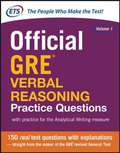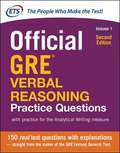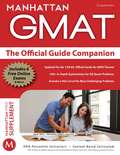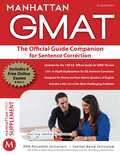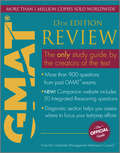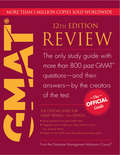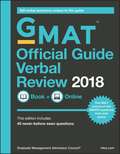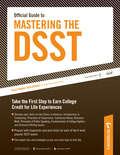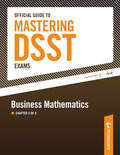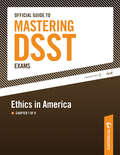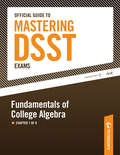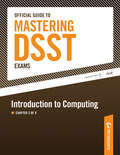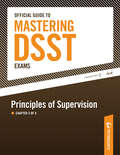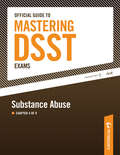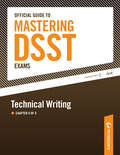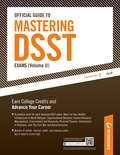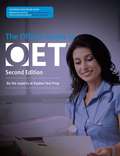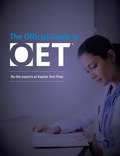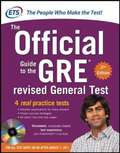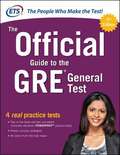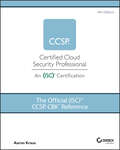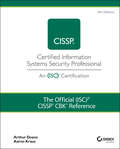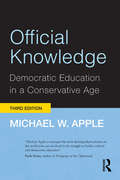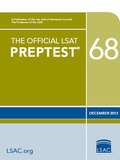- Table View
- List View
Official GRE Verbal Reasoning Practice Questions (Volume #1)
by Educational Testing Service Staff150 REAL GRE Verbal Reasoning questions--direct from the test maker! The best way to prepare for the Verbal Reasoning measure of the GRE revised General Test is with real GRE test questions--and that is what you will find in this unique guide! Specially created for you by ETS, it offers 150 actual GRE Verbal Reasoning questions with complete explanations. Plus, this guide includes an authoritative overview of the GRE Analytical Writing measure, completewith sample writing tasks and scored sample responses. Only ETS can show you exactly what to expect on the test. So for in-depth practice and accurate, reliable test preparation for the GRE Verbal Reasoning measure, this guide is your best choice! Look inside to find: Real GRE Verbal Reasoning test questions arranged by question type and difficulty level--to help you build your test-taking skills. Plus, mixed practice sets. Answers and explanations for every question! ETS's own test-taking strategies: Valuable hints and tips that can help you do your best on the test. Official information on the GRE Verbal Reasoning measure: The facts about test content, structure, and scoring--straight from ETS. Plus: An overview of the GRE Analytical Writing measure with writing strategies, sample writing tasks, and sample scored essays.
Official GRE Verbal Reasoning Practice Questions (Second Edition)
by Educational Testing ServiceThe best way to prepare for the Verbal Reasoning measure of the GRE® General Test is with real GRE test questions--and that is what you will find in this unique guide. Specially created by the actual test maker, it offers 150 actual GRE Verbal Reasoning questions with complete explanations. This guide also includes an authoritative overview of the GRE Analytical Writing measure, complete with sample writing tasks and scored sample responses.
Official Guide Companion
by Manhattan GmatThis book is designed to be used in conjunction with the Official Guide for GMAT Review, 2015 and 13th Editions. In the Official Guide Companion, each math question is broken down and explained by our expert instructors, who not only have 99th percentile scores, but years of experience teaching the GMAT. The explanations in this book provide detailed, step-by-step approaches to every Problem Solving and Data Sufficiency question in the Official Guide. Where appropriate, The Official Guide Companion also details more than one way to arrive at the solution. And perhaps most importantly, all explanations are accessible and provide a framework for answering the particular question as well as similar questions you may see on the real test. Purchase of this book includes six months of online access to 6 full-length, computer-adaptive practice exams and GMAT Navigator.
Official Guide Companion for Sentence Correction
by Manhattan GmatThe Official Guide Companion for Sentence Correction is designed to be used in conjunction with the Official Guide for GMAT Review, 2015 and 13th Editions. Written by Manhattan GMATâ TMs 99th-percentile instructors, this book breaks down and explains each of the 140 sentence correction problems contained in the GMAT Official Guide in a clear and simple manner accessible to students of all ability levels. The explanations in this book focus in on the solving process and work to emphasize the connection between sentence meaning, structure, and correct grammar. Furthermore, all explanations align with the methodology and grammar rules taught in Manhattan GMATâ TMs complete courses and provide a framework for answering any sentence correction questions you may see on the real test. Purchase of this book includes six months of online access to 6 full-length, computer-adaptive practice exams and GMAT Navigator.
The Official Guide for GMAT Review
by GMACThe most trusted source for studying the GMAT test, written by GMAC - the creators of the exam. The Official Guide to the GMAT, 13th Edition is the most up-to-date study guide for the GMAT test, containing 50 official questions from the new Integrated Reasoning component which was fully integrated into the test in June 2012. Because this component is more interactive than other core components in the GMAT exam (Verbal, Quantitative, and Analytical Writing), the Integrated Reasoning practice questions will be housed on a companion website that readers will be able to access after purchasing the book*. Includes: More than 900 questions from past GMAT exams Diagnostic section helps you assess where to focus your test-prep efforts Full answers and detailed explanations for practice questions Grammar review covering concepts tested in the GMAT Verbal section Comprehensive math review of the topics tested in the GMAT Quantitative section Actual essay topics, sample responses and scoring information Questions organized in order of difficulty to save study time Don't settle for anything less when studying for the GMAT test, purchase the Official Guide today. *To use the Integrated Reasoning companion website, you must have one of the following browsers: Safari, Google Chrome, Firefox, or Internet Explorer version 7 or higher.
The Official Guide for GMAT Review
by Graduate Management Admission CouncilTrust the worldwide bestselling study guide to help you prepare for the GMAT!The Official Guide for GMAT Review - 12th EditionHere's what you'll find inside the only book on the market written by the creators of the exam.More than 800 questions from past GMAT tests - including 250 that have never before been publishedFull answers and detailed explanations for all questionsGrammar review covering concepts tested on the GMAT Verbal sectionComprehensive math review of the topics tested on the GMAT Quantitative sectionActual essay topics, sample responses, and scoring informationQuestions organized in order of difficulty to save study timeAlso available:The Official Guide to GMAT Quantitative Review, 2nd EditionThe Official Guide to GMAT Verbal Review, 2nd Edition
The Official Guide For GMAT Verbal Review 2018
by Graduate Management Admission Council (GMAC) StaffA supplement to the Official Guide with 300 additional verbal questions The GMAT Official Guide 2018 Verbal Review provides additional practical preparation focused on the verbal portion of the exam. Written by the Graduate Management Admission Council, this guide contains 300 real GMAT questions from past exams, including 45 never-before-seen questions, plus the following features: An overview of the exam to help you get familiar with the content and format Comprehensive grammar review Detailed answer explanations that explain how the test maker thinks about a question Questions organized in order of difficulty from easiest to hardest to focus your study Access to the same questions online at gmat. wiley. com, where you can build your own practice sets Don't waste time practicing on fake GMAT questions. Optimize your study time with the GMAT Official Guide 2018 Verbal Review using real questions from actual past exams.
Official Guide to Mastering DSST Exams
by Peterson’sPeterson's Official Guide to Mastering the DSST Exams helps nontraditional students earn college credits for life and learning experiences, with diagnostic tests, subject review, and post-tests (with detailed answer explanations) for each of the 8 most popular DSST exams: Ethics in America, Introduction to Computing, Principles of Supervision, Substance Abuse, Business Math, Principles of Public Speaking, Fundamentals of College Algebra, and Technical Writing. Peterson's Official Guide to Mastering the DSST Exams is the only prep guide endorsed by PrometricTM, the DSST program provider, which found this study guide to be an excellent reflection of the content of the respective DSST tests.
Official Guide to Mastering DSST Exams--Business Mathematics: Chapter 5 of 8
by Peterson's"A part of Peterson's Official Guide to Mastering the DSST Exams--Business Mathematics helps nontraditional students earn college credits for life and learning experiences, with a diagnostic test, subject review, and post-test (with detailed answer explanations) for this popular DSST exam: Business Mathematics. Topics covered include algebraic concepts, statistics, business applications, and financial mathematics. Peterson's Official Guide to Mastering the DSST Exams is the only prep guide endorsed by PrometricTM, the DSST program provider, which found this study guide to be an excellent reflection of the content of the respective DSST tests."
Official Guide to Mastering DSST Exams--Ethics in America: Chapter 1 of 8
by Peterson's"A part of Peterson's Official Guide to Mastering the DSST Exams--Ethics in America helps nontraditional students earn college credits for life and learning experiences, with a diagnostic test, subject review, and post-test (with detailed answer explanations) for this popular DSST exam: Ethics in America. Topics include ethical traditions, religious traditions, natural law theory, political theories, transcendentalism idealism, moral egoism, feminist ethics, current ethical issues, and more. Peterson's Official Guide to Mastering the DSST Exams is the only prep guide endorsed by PrometricTM, the DSST program provider, which found this study guide to be an excellent reflection of the content of the respective DSST tests."
Official Guide to Mastering DSST Exams--Fundamentals of College Algebra: Chapter 7 of 8
by Peterson's"A part of Peterson's Official Guide to Mastering the DSST Exams--Fundamentals of College Algebra helps nontraditional students earn college credits for life and learning experiences, with a diagnostic test, subject review, and post-test (with detailed answer explanations) for this popular DSST exam: Fundamentals of College Algebra. Topics include fundamental algebraic operations, rational expressions, exponential and radical expressions, linear equations, absolute value equations and inequalities, quadratic equations and inequalities, complex numbers, functions, two-dimensional graphing, and more. Peterson's Official Guide to Mastering the DSST Exams is the only prep guide endorsed by PrometricTM, the DSST program provider, which found this study guide to be an excellent reflection of the content of the respective DSST tests."
Official Guide to Mastering DSST Exams--Introduction to Computing: Chapter 2 of 8
by Peterson's"A part of Peterson's Official Guide to Mastering the DSST Exams--Introduction to Computing helps nontraditional students earn college credits for life and learning experiences, with a diagnostic test, subject review, and post-test (with detailed answer explanations) for this popular DSST exam: Introduction to Computing. Topics include computers: history and the basics; software: system and application; software copyrights and licenses; software development; network communication, and security; and more. Peterson's Official Guide to Mastering the DSST Exams is the only prep guide endorsed by PrometricTM, the DSST program provider, which found this study guide to be an excellent reflection of the content of the respective DSST tests."
Official Guide to Mastering DSST Exams--Principles of Public Speaking: Chapter 6 of 8
by Peterson's"A part of Peterson's Official Guide to Mastering the DSST Exams--Principles of Public Speaking helps nontraditional students earn college credits for life and learning experiences, with a diagnostic test, subject review, and post-test (with detailed answer explanations) for this popular DSST exam. Topics include ethical considerations in public speaking, audience analysis and adaptation, speech topics and purposes, research and organization; criticizing and evaluating speeches, and more. Peterson's Official Guide to Mastering the DSST Exams is the only prep guide endorsed by PrometricTM, the DSST program provider, which found this study guide to be an excellent reflection of the content of the respective DSST tests."
Official Guide to Mastering DSST Exams--Principles of Supervision: Chapter 3 of 8
by Peterson's"A part of Peterson's Official Guide to Mastering the DSST Exams--Principles of Supervision helps nontraditional students earn college credits for life and learning experiences, with a diagnostic test, subject review, and post-test (with detailed answer explanations) for this popular DSST exam: Principles of Supervision. Topics include management levels, skill requirements, managerial roles, business ethics, corporate social responsibility, organizational environment, management functions, and more. Peterson's Official Guide to Mastering the DSST Exams is the only prep guide endorsed by PrometricTM, the DSST program provider, which found this study guide to be an excellent reflection of the content of the respective DSST tests."
Official Guide to Mastering DSST Exams--Substance Abuse: Chapter 4 of 8
by Peterson's"A part of Peterson's Official Guide to Mastering the DSST Exams--Substance Abuse helps nontraditional students earn college credits for life and learning experiences, with a diagnostic test, subject review, and post-test (with detailed answer explanations) for this popular DSST exam: Substance Abuse. Topics include drugs: classifications and effects; alcohol: history, effects, and dependency; sedative hypnotics; inhalants; stimulants: cocaine and amphetamines; and more. Peterson's Official Guide to Mastering the DSST Exams is the only prep guide endorsed by PrometricTM, the DSST program provider, which found this study guide to be an excellent reflection of the content of the respective DSST tests."
Official Guide to Mastering DSST Exams--Technical Writing: Chapter 8 of 8
by Peterson's"A part of Peterson's Official Guide to Mastering the DSST Exams--Technical Writing helps nontraditional students earn college credits for life and learning experiences, with a diagnostic test, subject review, and post-test (with detailed answer explanations) for this popular DSST exam: Technical Writing. Topics include progress, feasibility, and laboratory reports; correspondence: memos, letters, and resumes; organizing technical content, technical editing, and much more. Peterson's Official Guide to Mastering the DSST Exams is the only prep guide endorsed by PrometricTM, the DSST program provider, which found this study guide to be an excellent reflection of the content of the respective DSST tests."
Official Guide to Mastering DSST Exams Volume II
by Peterson'sThe only official prep guide from the makers of the DSSTs, Peterson's Official Guide to Mastering DSST Exams includes full-length DANTES Subject Standardized Tests (DSSTs) on a variety of subjects to help non-traditional students earn college credits for life and learning experiences. * Full-length DSSTs with detailed answer explanations * Reviews of verbal, clerical, math, and memory skills you'll need to score high * Expert tips and strategies from the editorial team that writes and prepares actual DSSTs * Offers students a cost-effective, time-saving way to use the knowledge they've acquired outside of the classroom to accomplish their education goals
Official Guide to OET (Kaplan Test Prep)
by Kaplan Test PrepThe Official Guide to OET is the first guide book endorsed by the test maker (CBLA) and is designed to prepare students for the updated OET exam. Kaplan Test Prep, the world leader in test preparation since 1938, has authored this book incorporating key test-taking tips and strategies. The practice questions have been reviewed by CBLA to ensure they are true to the test.Get familiar with the exam to help you face the OET with confidence. Test-like Listening tracks, realistic practice questions, and additional online resources give you everything you need to succeed on the OET. This book is suitable for both self-study and classroom use.To access your audio and online resources, first register online at kaptest.com/booksonline. Once you&’ve registered, access your audio and resources at kaptest.com/login or download the Kaplan Mobile Prep app on Google Play or the App Store for your Android or iOS deviceTips and Practice1 full practice testOnline audio for Listening contentSkill-boosting activities for each of the subtests (Listening, Reading, Writing & SpeakingSelf-study tipsTest Day adviceExpert GuidanceWe know the test: The Kaplan team in conjunction with CBLA ensure our practice questions and study materials are true to the testKaplan's books and practice questions are written by experts who know students—every explanation is written to help you learnWe invented test prep—Kaplan (www.kaptestglobal.com) has been helping students for 80 years, and our proven strategies have helped legions of students achieve their dreams
Official Guide to OET
by Kaplan Test PrepThe Official Guide to OET is the first and only guide book endorsed by the test maker (CBLA) and is designed to prepare students for the updated OET exam. Kaplan Test Prep, the world leader in test preparation since 1938, has authored this book incorporating key test-taking tips and strategies. The practice questions have been reviewed by CBLA to ensure they are true to the test.Get familiar with the exam to help you face the OET with confidence. Test-like Listening tracks, realistic practice questions, and additional online resources give you everything you need to succeed on the OET. This book is suitable for both self-study and classroom use.Tips and Practice1 full practice testOnline audio for Listening contentSkill-boosting activities for each of the subtests (Listening, Reading, Writing & SpeakingSelf-study tipsTest Day adviceExpert GuidanceWe know the test: The Kaplan team in conjunction with CBLA ensure our practice questions and study materials are true to the testKaplan's books and practice questions are written by experts who know students—every explanation is written to help you learnWe invented test prep—Kaplan (www.kaptestglobal.com) has been helping students for 80 years, and our proven strategies have helped legions of students achieve their dreams
The Official Guide to the GRE
by Educational Testing ServiceGet the only official guide to the GRE® revised General Test that comes straight from the test makers! If you're looking for the best, most authoritative guide to the GRE revised General Test, you've found it! The Official Guide to the GRE revised General Test is the only GRE guide specially created by ETS--the people who actually make the test. It's packed with everything you need to do your best on the test--and move toward your graduate or business school degree. Only ETS can show you exactly what to expect on the test, tell you precisely how the test is scored, and give you hundreds of authentic test questions for practice! That makes this guide your most reliable and accurate source for everything you need to know about the GRE revised General Test. No other guide to the GRE revised General Test gives you: Four complete, real tests--two in the book and two on CD-ROM Hundreds of authentic test questions--so you can study with the real thing In-depth descriptions of the Verbal Reasoning and Quantitative Reasoning measures plus valuable tips for answering each question type Detailed overview of the two types of Analytical Writing essay tasks including scored sample responses and actual raters' comments Everything you need to know about the test, straight from the test makers!
The Official Guide to the GRE General Test (Third Edition)
by Educational Testing ServiceGet the only official guide to the GRE General Test that comes straight from the test makers! If you're looking for the best, most authoritative guide to the GRE General Test, you've found it! The Official Guide to the GRE General Test is the only GRE guide specially created by ETS--the people who actually make the test. It's packed with everything you need to do your best on the test and move toward your graduate or business school degree. Only ETS can show you exactly what to expect on the test, tell you precisely how the test is scored, and give you hundreds of authentic test questions for practice! That makes this guide your most reliable and accurate source for everything you need to know about the GRE revised General Test. No other guide to the GRE General Test gives you all this:Hundreds of authentic test questions--so you can study with the real thing In-depth descriptions of the Verbal Reasoning and Quantitative Reasoning measures plus valuable tips for answering each question type Quantitative Reasoning problem-solving steps and strategies to help you get your best score Detailed overview of the two types of Analytical Writing essay tasks including scored sample responses and actual raters' comments. Everything you need to know about the test, straight from the test makers!
The Official (ISC)2 CCSP CBK Reference
by Aaron KrausThe only official body of knowledge for CCSP—the most popular cloud security credential—fully revised and updated. Certified Cloud Security Professional (CCSP) certification validates the advanced technical skills needed to design, manage, and secure data, applications, and infrastructure in the cloud. This highly sought-after global credential has been updated with revised objectives. The new third edition of The Official (ISC)2 Guide to the CCSP CBK is the authoritative, vendor-neutral common body of knowledge for cloud security professionals. This comprehensive resource provides cloud security professionals with an indispensable working reference to each of the six CCSP domains: Cloud Concepts, Architecture and Design; Cloud Data Security; Cloud Platform and Infrastructure Security; Cloud Application Security; Cloud Security Operations; and Legal, Risk and Compliance. Detailed, in-depth chapters contain the accurate information required to prepare for and achieve CCSP certification. Every essential area of cloud security is covered, including implementation, architecture, operations, controls, and immediate and long-term responses. Developed by (ISC)2, the world leader in professional cybersecurity certification and training, this indispensable guide: Covers the six CCSP domains and over 150 detailed objectives Provides guidance on real-world best practices and techniques Includes illustrated examples, tables, and diagrams The Official (ISC)2 Guide to the CCSP CBK is a vital ongoing resource for IT and information security leaders responsible for applying best practices to cloud security architecture, design, operations and service orchestration.
The Official (ISC)2 CISSP CBK Reference
by Arthur J. Deane Aaron KrausThe only official, comprehensive reference guide to the CISSP Thoroughly updated for 2021 and beyond, this is the authoritative common body of knowledge (CBK) from (ISC)2 for information security professionals charged with designing, engineering, implementing, and managing the overall information security program to protect organizations from increasingly sophisticated attacks. Vendor neutral and backed by (ISC)2, the CISSP credential meets the stringent requirements of ISO/IEC Standard 17024. This CBK covers the current eight domains of CISSP with the necessary depth to apply them to the daily practice of information security. Revised and updated by a team of subject matter experts, this comprehensive reference covers all of the more than 300 CISSP objectives and sub-objectives in a structured format with: Common and good practices for each objective Common vocabulary and definitions References to widely accepted computing standards Highlights of successful approaches through case studies Whether you've earned your CISSP credential or are looking for a valuable resource to help advance your security career, this comprehensive guide offers everything you need to apply the knowledge of the most recognized body of influence in information security.
Official Knowledge: Democratic Education in a Conservative Age
by Michael W. AppleThis third edition of Official Knowledge, a classic text from one of education’s most distinguished scholars, challenges readers to critically examine how certain knowledge comes to be “official,” and whose agendas this knowledge represents. A probing and award-winning study, this new edition builds on the tradition of its predecessors to question the rightist resurgence in education while substantive updates throughout show how such policies continue to define our commonsense notions about what counts as a good school. A new preface and two full, new chapters address current controversies over curriculum and textbooks, and extend the discussion of previous editions to reflect on some of the most important pressures being placed on higher education as well. Apple also considers the recent conversion of some prominent neoliberal, neoconservative, and managerial thinkers to more critical understandings of educational policies, proving that progressive change is possible if we examine the roots of these ideologies in the first place. As insightful as it is thorough, Official Knowledge is a refreshing call to challenge the dominant forces within education today, as Apple powerfully illustrates how larger social movements are only possible if we purposefully and inclusively deepen our understanding of the existing body of knowledge about education.
The Official Lsat Preptest 68
by Law School Admission CouncilThe "PrepTest" is an actual LSAT administered on the date indicated. Practice as if taking an actual test by following the test-taking instructions and timing yourself. In addition to actual LSAT questions, each "PrepTest" contains an answer key, writing sample, and score-conversion table.
